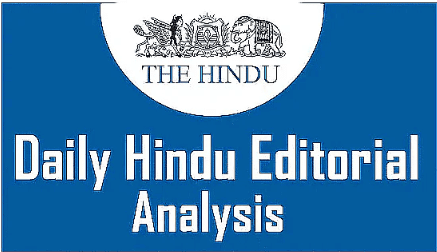The Hindu Editorial Analysis- 29th August 2024 | Current Affairs & Hindu Analysis: Daily, Weekly & Monthly - UPSC PDF Download

Sharpening India’s Anti-tuberculosis Fight
Why in News?
The widespread existence of tuberculosis (TB) in history and literature shows how the sickness has troubled many generations globally and remains a significant issue today.
- India carries more than a quarter of the total TB burden worldwide.
- In India, strong governmental determination has led to substantial progress in combating TB.
- In 2023, efforts to find 'missed' TB cases resulted in the diagnosis of 25.1 lakh patients in India, indicating improved case detection endeavors.
- As we strive for the elimination of TB, emphasized by the Prime Minister, it is essential to innovate and utilize established technologies and tools effectively.
What is Tuberculosis?
- About: Tuberculosis is a type of bacterial infection caused by Mycobacterium tuberculosis. It can affect various parts of the body such as the lungs, pleura, lymph nodes, intestines, spine, and brain.
- Transmission: Tuberculosis spreads through the air and usually happens when someone is in close contact with an infected person, especially in crowded places with poor air circulation.
- Symptoms: Common signs of active lung TB include coughing with phlegm and sometimes blood, chest discomfort, weakness, weight loss, fever, and night sweats.
- Infection Prevalence: Every year, around 10 million individuals become sick with tuberculosis. Despite being preventable and treatable, 1.5 million people lose their lives due to TB annually, making it the most deadly infectious disease worldwide.
- Global Impact: Tuberculosis is a leading cause of death among individuals with HIV and is a significant factor in antimicrobial resistance. Most TB cases occur in low- and middle-income nations, although the disease is present globally. Approximately half of all TB cases are concentrated in eight countries: Bangladesh, China, India, Indonesia, Nigeria, Pakistan, the Philippines, and South Africa.

- Treatment:
- Tuberculosis (TB) is treated with a standard 6-month regimen of four antimicrobial medications. A health worker or trained volunteer provides these drugs along with guidance and support to the patient.
- A history of using anti-TB drugs exists, but there are strains resistant to at least one of these drugs in all countries studied.
- Multidrug-resistant Tuberculosis (MDR-TB) is a type of TB caused by bacteria that do not react to isoniazid and rifampicin, the two most potent primary anti-TB medications.
- MDR-TB can be managed and cured by utilizing alternative drugs like bedaquiline.
- Extensively drug-resistant TB (XDR-TB) is a severe version of MDR-TB caused by bacteria unresponsive to the most effective secondary anti-TB medications, often leaving patients with no further treatment alternatives.
- Drugs for TB:
- Isoniazid (INH): This medication is crucial in TB treatment and is highly effective against Mycobacterium tuberculosis. It operates by hindering the production of mycolic acids in the bacterial cell wall.
- Rifampicin (RIF): Another vital drug in TB treatment, rifampicin functions by impeding RNA synthesis in the bacteria. It is commonly utilized alongside other medications for TB treatment and is pivotal in preventing drug resistance development.
- Delamanid: Delamanid is a recent addition to TB treatment and is employed in managing multidrug-resistant TB (MDR-TB), often in conjunction with other medications.
What are Different Initiatives to Combat TB?
- Global Efforts:
- The WHO has started a new project called "Find. Treat. All. #EndTB" with the Global Fund and Stop TB Partnership.
- WHO also publishes the Global Tuberculosis Report.
- The Global Plan to Stop TB, 2023-2030, is a strategy to end TB as a major public health problem by 2030. It outlines key actions needed and estimates the funds required to achieve this goal.
- This objective has been agreed upon by all United Nations (UN) Member States and the WHO.
- The End TB Strategy expands efforts in line with the UN Sustainable Development Goal 3.3.
- India's Efforts:
- Pradhan Mantri TB Mukt Bharat Abhiyan is an initiative in India to combat TB.
- The National Strategic Plan (NSP) for Tuberculosis Elimination (2017-2025) is in place.
- There is a campaign in India called "TB Harega Desh Jeetega."
- Nikshay Poshan Yojna is another program in India aimed at tackling TB.
- RePORT India is a collaborative effort established in 2013 to study TB and its impact in India and globally.
Conclusion
The journey to eliminating TB in India needs a strong focus on putting individuals at the center, dealing with factors that affect health, and welcoming new ideas. By taking a complete and person-centered approach, India can overcome the obstacles to TB management and build a healthier future for everyone.
UPSC Civil Services Examination, Previous Year Questions (PYQs)
Prelims
Q. Which of the following are the objectives of ‘National Nutrition Mission’? (2017)
i)To create awareness relating to malnutrition among pregnant women and lactating mothers.
ii)To reduce the incidence of anaemia among young children, adolescent girls and women.
iii)To promote the consumption of millets, coarse cereals and unpolished rice.
iv)To promote the consumption of poultry eggs.
Select the correct answer using the code given below:
(a) 1 and 2 only
(b) 1, 2 and 3 only
(c) 1, 2 and 4 only
(d) 3 and 4 only
Ans: (a)
Mains
Q. “Besides being a moral imperative of a Welfare State, primary health structure is a necessary precondition for sustainable development.” Analyse. (2021)
|
52 videos|5374 docs|1136 tests
|
















